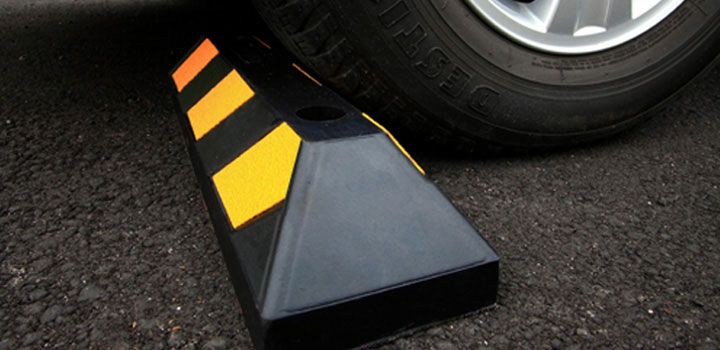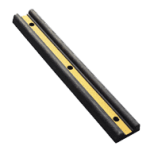Definition and Types
Parking bumpers, also known as wheel stops or parking blocks, are physical barriers used in parking lots to prevent vehicles from rolling beyond a certain point. Their primary purpose is to protect pedestrians, vehicles, and property by delineating parking spaces and restricting vehicle overhang.
Parking bumpers come in various types, each suited to different parking environments:
- Concrete Bumpers: Heavy and durable, ideal for long-term use in commercial settings.
- Rubber Bumpers: Flexible and less damaging to vehicles upon impact, often used in residential and light commercial areas.
- Plastic Bumpers: Lightweight and resistant to weather conditions, suitable for both temporary and permanent installations.
- Metal Bumpers: Strong and long-lasting, typically used in industrial settings where heavy vehicles are common.
The choice of parking bumper type depends on factors such as the expected traffic volume, the type of vehicles using the parking lot, and the specific needs of the property.
Materials Used in Construction
Parking bumpers, also known as wheel stops or parking blocks, are typically constructed from a variety of materials, each offering distinct benefits. Concrete is the most traditional material, prized for its durability and strength. However, it can be heavy and difficult to transport.
Rubber parking bumpers from https://unimat-traffic.com/ are becoming increasingly popular due to their lighter weight and flexibility, which can reduce the risk of damage to the vehicle in the event of an impact. Recycled plastic models offer an environmentally friendly alternative, often featuring increased resistance to weathering and corrosion.
- Concrete
- Rubber
- Recycled Plastic
- Steel Reinforced
Steel-reinforced options combine concrete’s sturdiness with steel’s resilience, making them suitable for high-traffic areas. When selecting materials for parking bumpers, it’s essential to consider the specific needs of the parking area, such as climate, traffic volume, and aesthetic preferences.
The choice of material not only affects the bumper’s performance but also its installation requirements and long-term maintenance needs.
Standard Dimensions and Placement
Parking bumpers, commonly referred to as wheel stops or parking blocks, come in various standard dimensions to accommodate different vehicle sizes and parking space requirements. The typical length of a parking bumper is 6 feet, which provides adequate space for most passenger vehicles to park without overhanging onto sidewalks or landscaping.
| Material | Length | Width | Height |
|---|---|---|---|
| Concrete | 6 ft | 5 in | 4 in |
| Plastic | 6 ft | 6 in | 4 in |
| Rubber | 4-6 ft | 6 in | 4 in |
Proper placement is crucial for the effectiveness of parking bumpers. They should be installed in a way that they are visible to drivers and do not pose a tripping hazard to pedestrians. Placement typically involves aligning the bumpers with the front of the parking space, ensuring they are parallel to each other and evenly spaced.
It’s important to adhere to local regulations and ADA guidelines when installing parking bumpers to ensure they contribute to a safe and accessible parking environment.
Functional Advantages of Parking Bumpers
Vehicle Safety and Damage Prevention
Parking bumpers play a crucial role in maintaining vehicle safety and preventing damage. They act as a physical barrier, preventing cars from rolling beyond the designated parking space, which can lead to collisions with other vehicles or pedestrians.
- Prevents vehicles from encroaching onto sidewalks or pedestrian areas
- Reduces the likelihood of fender benders when parking
- Helps drivers gauge the parking space limit, especially in tight spots
Parking bumpers are an essential component in any parking lot, providing a simple yet effective solution for protecting vehicles and pedestrians alike.
Their strategic placement can also prevent cars from inadvertently damaging landscaping, storefronts, or other parked cars, thereby reducing the potential for costly repairs and insurance claims.
Improved Parking Efficiency
Parking bumpers play a crucial role in maximizing the use of space within parking lots. By clearly delineating parking spots, they help drivers align their vehicles more quickly and efficiently, reducing the time spent maneuvering.
- Ensure consistent parking spot sizes
- Guide drivers to park in an orderly fashion
- Prevent vehicles from encroaching into adjacent spaces or traffic lanes
Parking bumpers contribute to a smoother flow of traffic within the parking area, as they provide visual cues that assist drivers in parking correctly the first time.
The strategic placement of parking bumpers can also facilitate better traffic patterns, minimizing the risk of accidents and congestion. This efficiency not only benefits drivers but also parking lot operators by allowing for a higher turnover of parking spaces.
Accessibility and ADA Compliance
Parking bumpers play a crucial role in ensuring accessibility for individuals with disabilities. They are instrumental in delineating accessible parking spaces, which are mandated by the Americans with Disabilities Act (ADA). Proper placement and dimensions of parking bumpers can help in maintaining clear access routes and prevent vehicles from encroaching into the necessary space required for wheelchair transfers.
- Parking bumpers must be installed in a way that does not obstruct the path of travel to the accessible entrance.
- They should be detectable by cane for visually impaired individuals.
- The height of parking bumpers should not exceed 6 inches to prevent tripping hazards.
Compliance with ADA guidelines not only supports inclusivity but also protects property owners from potential legal issues. Ensuring that parking bumpers meet these standards is essential for creating an accessible environment for all users.
Aesthetic and Environmental Benefits
Enhancing Parking Lot Appearance
Parking bumpers play a subtle yet significant role in enhancing the overall appearance of parking lots. Well-designed parking bumpers can contribute to a neat and organized look, delineating parking spaces clearly and adding to the visual appeal of the area.
- They can be color-coordinated with the lot’s design scheme.
- Textured or patterned options add a touch of sophistication.
- Strategically placed bumpers can guide traffic flow and create a more welcoming environment.
The right choice of parking bumpers can transform a mundane parking lot into a space that reflects the property’s professionalism and attention to detail.
In addition to their functional role, parking bumpers serve as a canvas for aesthetic expression. By selecting bumpers that complement the surrounding architecture and landscape, property managers can elevate the ambiance of a parking area, making it more inviting for users.
Eco-Friendly Options
In the realm of parking bumpers, eco-friendly options are gaining traction as a means to reduce environmental impact. Recycled materials are at the forefront of this movement, with many parking bumpers now being made from repurposed rubber or plastic. These materials not only divert waste from landfills but also require less energy to produce than their virgin counterparts.
The use of eco-friendly parking bumpers aligns with broader sustainability goals and can contribute to a company’s green credentials.
Eco-friendly parking bumpers come with several benefits:
- Reduced carbon footprint: Manufacturing from recycled materials typically has a lower carbon footprint.
- Durability: Many eco-friendly options are just as durable as traditional materials, if not more so.
- Cost-effective: Over time, the lower environmental impact can translate to economic savings.
By choosing eco-friendly parking bumpers, businesses and municipalities can demonstrate their commitment to sustainability while still ensuring the functionality and safety of their parking facilities.
Contribution to Landscaping and Design
Parking bumpers can play a significant role in the overall landscaping and design of a parking area. They serve as visual cues that can enhance the organization and flow of a parking lot, delineating spaces and guiding traffic effectively.
- Aesthetics: Parking bumpers can be colored or textured to complement the surrounding environment.
- Integration: They can be integrated with green spaces, such as gardens or grassy areas, to break up the expanse of pavement.
- Customization: Options for customization allow for unique designs that can reflect the character of a business or locality.
Parking bumpers, beyond their practical function, contribute to the creation of a pleasant and cohesive visual experience for visitors and employees alike.
The thoughtful placement and choice of parking bumpers can significantly elevate the visual appeal of a parking lot, making it more inviting and user-friendly. This attention to detail can leave a lasting positive impression on those who visit the facility.
Installation and Maintenance
Installation Process
The installation of parking bumpers is a straightforward process that can be completed with minimal tools and expertise. Proper installation is crucial to ensure the bumpers function as intended and last for many years.
- Determine the precise location for each bumper according to the parking lot layout.
- Clean the surface area to remove any debris that might interfere with installation.
- Position the bumper and mark the spots where the anchoring will take place.
- Drill holes and secure the bumpers with appropriate hardware, such as concrete anchors or spikes for asphalt.
It’s important to follow the manufacturer’s guidelines for spacing and securing the bumpers to maintain their effectiveness and durability.
Longevity and Durability
The longevity and durability of parking bumpers are critical factors that contribute to their cost-effectiveness over time. High-quality parking bumpers can withstand the wear and tear of daily use, exposure to harsh weather conditions, and the impact of vehicle contact.
- Materials: The choice of material significantly affects the bumper’s lifespan. Concrete and rubber are common choices, each with its own lifespan and resilience.
- Design: Properly designed bumpers resist cracking and chipping, which extends their service life.
- Reinforcement: Some bumpers include steel reinforcement to enhance strength and durability.
The installation method also plays a pivotal role in ensuring the bumpers remain firmly in place and functional for years. Secure installation can prevent shifting and damage, thereby extending the life of the parking bumpers.
Maintenance Tips and Best Practices
Maintaining parking bumpers is essential for ensuring their longevity and effectiveness. Regular inspections should be conducted to check for wear and tear, such as cracks or chips, which can compromise the bumper’s structural integrity.
- Clean regularly to prevent buildup of dirt and debris that can cause deterioration.
- Re-paint as needed to maintain visibility and appearance.
- Re-anchor loose bumpers to ensure they remain effective in delineating parking spaces and protecting vehicles.
It’s important to address any issues promptly to avoid potential safety hazards or more costly repairs down the line.
For concrete bumpers, sealing may be necessary to protect against weather damage. For rubber or plastic bumpers, look for signs of fading or brittleness. A consistent maintenance schedule can greatly extend the life of parking bumpers and keep your parking lot safe and orderly.
Economic Considerations
Cost-Benefit Analysis
When considering the implementation of parking bumpers, a cost-benefit analysis is essential to determine their economic viability. The initial investment in parking bumpers can be offset by the long-term savings they provide. For instance, the reduction in parking-related accidents means fewer insurance claims, which can lead to lower premiums over time.
- Reduction in maintenance costs: Parking bumpers maintain clear parking delineations, reducing the need for frequent repainting of parking lot lines.
- Increased lifespan of parking surfaces: By preventing cars from overrunning curbs, parking bumpers help to preserve the integrity of the parking lot surface.
- Enhanced property value: Well-maintained parking facilities with clear safety features can contribute to the overall value of the property.
The strategic placement of parking bumpers can also optimize the use of space, allowing for more vehicles to be parked safely, which can increase potential revenue from parking fees.
While the upfront costs for purchasing and installing parking bumpers may seem significant, the long-term benefits often justify the expenditure. It is important for property owners to consider not only the immediate costs but also the potential financial advantages over the lifespan of the parking bumpers.
Potential Insurance Savings
Investing in parking bumpers can lead to potential insurance savings for property owners. By reducing the likelihood of accidents and vehicle damage within parking areas, the risk profile of the property is improved, which can be reflected in lower insurance premiums.
- Risk Mitigation: Parking bumpers act as a preventive measure against vehicle damage.
- Lower Claims: Fewer accidents result in fewer insurance claims, a key factor in premium calculations.
- Negotiation Leverage: Demonstrated safety improvements can be used to negotiate better insurance rates.
The strategic placement of parking bumpers can be a cost-effective way to enhance safety and potentially reduce insurance costs over time.
Long-Term Financial Advantages
Investing in high-quality parking bumpers can lead to significant long-term financial benefits. The reduction in maintenance and replacement costs contributes to overall savings, as durable parking bumpers withstand the test of time and elements.
- Lower frequency of replacements: Quality bumpers don’t need to be replaced as often.
- Reduced maintenance costs: Durable materials require less upkeep.
- Decreased liability: Properly installed bumpers can reduce the risk of accidents, potentially lowering insurance premiums.
The strategic placement of parking bumpers can also optimize parking space usage, increasing the number of vehicles that can be accommodated. This optimization can lead to increased revenue from parking fees, especially in high-demand areas.
In summary, while the initial investment in parking bumpers may be higher, the long-term savings and potential for increased revenue make them a financially sound choice for parking lot owners and managers.
Conclusion
In summary, parking bumpers serve as an essential component in modern parking lots, offering a multitude of advantages and benefits. From enhancing safety by preventing vehicles from overrunning parking spaces to protecting pedestrians, landscaping, and surrounding infrastructure, these simple yet effective tools play a crucial role. Moreover, their contribution to organized parking and the resulting maximization of space cannot be understated. The durability and low maintenance of parking bumpers further underscore their practicality and cost-effectiveness. As urban areas continue to grow and the demand for efficient parking solutions rises, the importance of parking bumpers is likely to increase, making them an indispensable element of urban planning and design.
Frequently Asked Questions
What are parking bumpers and why are they used?
Parking bumpers, also known as wheel stops or parking blocks, are physical barriers used in parking lots to prevent vehicles from going beyond a designated parking area. They are used to protect pedestrians, property, and the vehicles themselves from damage.
What materials are commonly used to make parking bumpers?
Parking bumpers are typically made from concrete, rubber, plastic, or recycled materials. The choice of material often depends on the specific needs of the parking area, such as durability, cost, and environmental considerations.
How do parking bumpers contribute to vehicle safety?
Parking bumpers act as a guide for drivers to properly position their vehicles within a parking space, reducing the risk of accidental collisions with other cars, pedestrians, or surrounding infrastructure.
Can parking bumpers help with ADA compliance?
Yes, when installed correctly, parking bumpers can assist in creating accessible parking spaces that comply with the Americans with Disabilities Act (ADA) by defining clear pathways and protecting accessible areas from being blocked by parked vehicles.
What are the environmental benefits of using eco-friendly parking bumpers?
Eco-friendly parking bumpers, often made from recycled materials, help reduce waste in landfills, minimize the use of non-renewable resources, and contribute to a greener parking solution.
What should be considered when installing parking bumpers?
When installing parking bumpers, factors such as the type of material, the size and layout of the parking lot, the expected traffic, and the local climate conditions should be considered to ensure proper placement and longevity.








